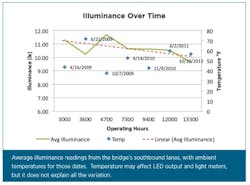A DOE Gateway Demonstration project on the I-35W freeway bridge in Minneapolis, MN began in 2008 and the solid-state lighting installation continues to perform suitably while having significantly reduced maintenance tasks relative to HPS lighting.
The US Department of Energy (DOE) has published an update on what was one of the first prominent outdoor LED lighting projects installed as part of the agency's Gateway Demonstration program back in 2008. The I-35W freeway bridge in Minneapolis, MN was lit with LED-based fixtures and is among the longest continually-operated solid-state lighting (SSL) installations in the world. After more than 20,000 hours of operation, the luminaires performed to expectations while high-pressure sodium (HPS) fixtures would have required at least one relamping cycle and most likely additional maintenance procedures.
The luminaires installed on the bridge were The Edge models from BetaLED prior to the acquisition of Ruud Lighting by Cree. We covered the first DOE Gateway report on the project that was published back in 2009. That first report noted that the LED products offered 13% energy savings relative to HPS lighting along with more uniform illumination across the wide span of the bridge.
The lighting has been periodically monitored over the course of the Gateway Demonstration. The Minnesota Department of Transportation (MnDOT) used a mobile monitoring system developed by the Virginia Tech Transportation Institute to collect seven sets of measurements between April 2009 and October 2011. Through 13,000 operating hours the average illuminance on the roadway dropped from just over 11 lx to just under 10 lx.
The project has provided useful data both relative to the use of LEDs and to lighting issues in general such as dirt depreciation or light losses attributable to dirty optics. Dirt depreciation was 4% after 5000 hours and 12% after 20,300 hours. The DOE noted that LED-based systems are typically specified with an expected 30% in lumen depreciation over the life of the system, and clearly dirt depreciation is a major contributor.
In 2013 the DOE removed the luminaires for an in-depth laboratory analysis of the photometric performance after 20,300 hours of usage. The report notes that although the products were very early-stage SSL products, the photometric performance matched or exceeded what could be expected from HPS lighting while delivering maintenance and energy savings.
Independent of dirt depreciation, the luminaires suffered lumen depreciation of an average 18%. Moreover, the luminaire efficacy declined by 15%. The report also notes a slight unexplained drop in input power over time. The actual output of the LEDs dropped by only 10% but an issue with the optics/materials added to the overall depreciation.
The report also noted that the CCT of the luminaires dropped by 800K over the course of usage with a corresponding reduction in CRI. Of course, HPS products are far inferior to even early LED-based products in terms of CRI.
Overall, the DOE says that MnDOT has been pleased with the test. The report noted that there were a few issues with the SSL products but that "no lighting installation, conventional or otherwise, is without issues." One LED driver had to be replaced, and MnDOT worked with BetaLED/Cree on the optics material issues in the fixture design.
You can download the original report and the recent Phase II report from the DOE SSL website.






